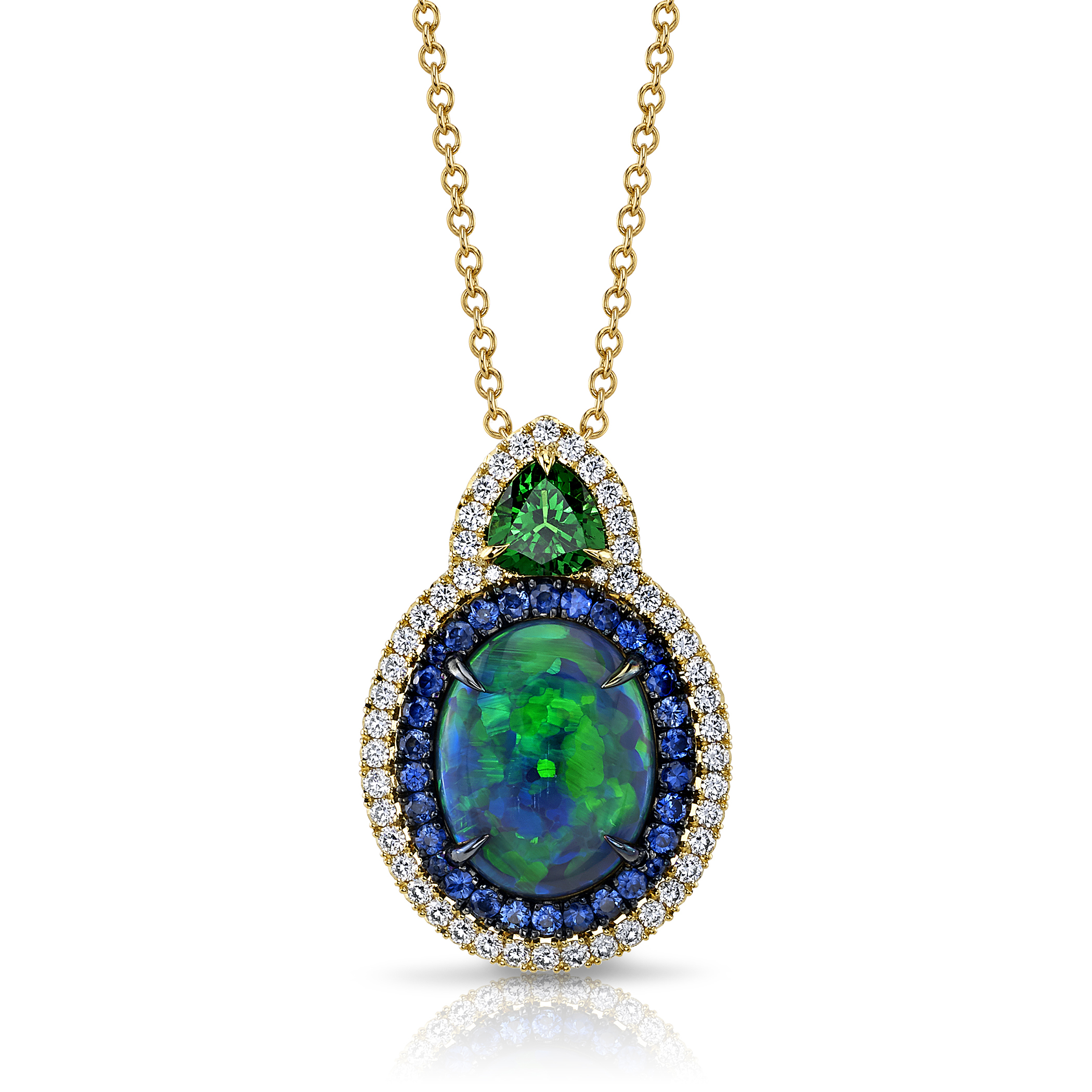

Opal, Tsavorite Garnet, Sapphire & Diamond Pendant
18K yellow gold pendant accented with black rhodium featuring a 2.96 carat oval black opal accented by a 0.50 carat trillion-cut tsavorite garnet, 0.32 carat total weight round diamond-cut sapphires and 0.32 carat total weight round diamonds.
P1479-PC1750-OPOV
Design Details
Black Opal, Tsavorite Garnet, Sapphire & Diamond Pendant
18K Yellow Gold w/ Black Rhodium
1 Black Opal Oval 2.96 ct. (12.06x9.43mm)
1 Tsavorite Trillion 0.50 ct. (5.0x5.0mm)
30 Sapphire Rd 0.32 ctw.
48 Diamond Rd 0.32ctw (F+/VS+)
On 18" 18K Yellow Gold Cable Chain (1.3mm)
Unique Design Traits
The black opal at the center of this pendant has a mesmerizing play-of-color pattern of blues and greens. This is mimicked in the halo with sapphires set where the greens of the opal are visible and tsavorites where the blues of the opal are visible.
Small details, like the single tsavorite garnet and sapphire set on the back of the pendant add personal touches to the design.
Bright 18K yellow gold set with diamonds adds a bold contrast to the center stone.
Gemstone Details
Black Opal
The highly prized Australian opal is one of nature’s true works of art. Recognized as the premiere source, the Lightning Ridge area of New South Wales produces a very finite supply of this phenomenal stone and no two opals are exactly alike. Each masterpiece is a complex palette of colors in blue, green, orange yellow and/or red. As you move the opal around in the light, flashes of color are revealed in the depths of the gem.
Black opals are the most valuable variety of opal and is distinguished by its black or dark ‘body tone’ which allows for the opal’s brilliant and vivid play of color. Of all black opals, those with red tones and patterns in the play of color will command the highest premium. Not all opals display play of color, and they are referred to as common opal. Opal is formed by silica and water over thousands of years. Spheres of silica stack in a regular order, and this internal structure diffracts light so play-of-color can be seen.
Opal is the birthstone for the month of October and the 14th anniversary gift.
Garnet Tsavorite
Tsavorite garnet is the green variety of the grossular group of garnets, with trace elements of vanadium or chromium providing its color. Tsavorite Garnet was discovered by British gem prospector Campbell R. Bridges in the mountains of north-east Tanzania in 1967. The name tsavorite was chosen by Tiffany & Co in reference to the initial discoveries in the area in and around Tsavo National Park.
Newer to market than most gemstones, Tsavorite was not promoted to the general public until 1974. Nonetheless, it has become one of the most expensive varieties of garnet. Large stones over one or two carats are quite rare and the color can be known to rival the greenest emeralds, while bring far less sensitive to handling.
Although tsavorite is the name usually associated with the darker green garnets in the grossulatire species, there is no universally accepted standard that designates which shade of green qualifies a stone as tsavorite. A great characteristic of tsavorite is its durability, with a hardness of 7.5 on the Moh's scale.
Garnet is the birthstone for January and the gift for the second wedding anniversary.
Blue Sapphire
Velvety blue. Liquid blue. Evening-sky blue. Cornflower blue. Sapphire, beloved for centuries as the ultimate blue gemstone. The ancient Persian rulers believed that the earth rested on a giant sapphire and its reflection colored the heavens blue.
But like the endless colors that appear in the sky, sapphire is also found in many other shades besides blue, from the gold of a sunrise, to the fiery reddish-orange of sunset, to the delicate violet of twilight. Sapphire may even resemble the pale white gloaming of an overcast day. These diverse colors are referred to as "fancy" color sapphires.
A gift of a sapphire symbolizes a pledge of trust and loyalty. It is from this tradition that sapphire has long been a popular choice for engagement rings. One of nature's most durable gemstones, sapphire shares this quality with its sister, the ruby.
Sapphire is found in many parts of the world, but the most prized sapphires are from Myanmar (Burma), Kashmir and Sri Lanka. The purer the blue of the sapphire, the greater the price the gemstone can command, however, many people find that the darker hues of sapphire can be just as appealing.
Over the centuries, methods have been developed to enhance the purest hues of sapphire. This is now commonly achieved by controlled heating, a technique that not only improves color but also improves clarity. But heating will only improve the color if the gemstone already contains the chemistry required. Heating sapphires is a permanent enhancement, as lasting as the gemstones themselves.
With a hardness of 9 on the Moh's scale, sapphire of any color is one of the hardest gemstones available save the diamond. Due to their crystal growth, larger sapphires are most often found in fancy brilliant cuts, like oval or cushion, large rounds and emerald cuts are markedly rarer to encounter.
Sapphire is the birthstone for September and the gem of the 5th and 45th anniversaries.

